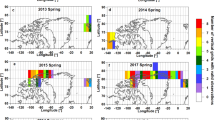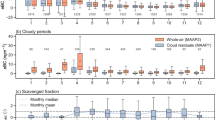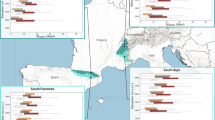Abstract
Black carbon in soot is the dominant absorber of visible solar radiation in the atmosphere. Anthropogenic sources of black carbon, although distributed globally, are most concentrated in the tropics where solar irradiance is highest. Black carbon is often transported over long distances, mixing with other aerosols along the way. The aerosol mix can form transcontinental plumes of atmospheric brown clouds, with vertical extents of 3 to 5 km. Because of the combination of high absorption, a regional distribution roughly aligned with solar irradiance, and the capacity to form widespread atmospheric brown clouds in a mixture with other aerosols, emissions of black carbon are the second strongest contribution to current global warming, after carbon dioxide emissions. In the Himalayan region, solar heating from black carbon at high elevations may be just as important as carbon dioxide in the melting of snowpacks and glaciers. The interception of solar radiation by atmospheric brown clouds leads to dimming at the Earth's surface with important implications for the hydrological cycle, and the deposition of black carbon darkens snow and ice surfaces, which can contribute to melting, in particular of Arctic sea ice.
This is a preview of subscription content, access via your institution
Access options
Subscription info for Japanese customers
We have a dedicated website for our Japanese customers. Please go to natureasia.com to subscribe to this journal.
Buy this article
- Purchase on SpringerLink
- Instant access to full article PDF
Prices may be subject to local taxes which are calculated during checkout





Similar content being viewed by others
References
Andreae, M. O. & Crutzen, P. J. Atmospheric aerosols: Bio-geochemical sources and role in atmospheric chemistry. Science 276, 1052–1056 (1997).
Penner, J. E. & Novakov, T. Carbonaceous particles in the atmosphere: A historical perspective to the Fifth International Conference on Carbonaceous Particles in the Atmosphere. J. Geophys. Res. 101, 19373–19378 (1996).
Andreae, M. O. & Geleneser, A. Black carbon or brown carbon? the nature of light-absorbing carbonaceous aerosols. Atmos. Chem. Phys. 6, 3131–3148 (2006).
Bond, T. C. et al. A technology-based global inventory of black and organic carbon emissions from combustion. J. Geophys. Res. 109, doi:10.1029/2003JD003697 (2004).
Russell, P. B., Hobbs, P. V., & Stowe, L. L. Aerosol properties and radiative effects in the United States East Coast haze plume: An overview of the Tropospheric Aerosol Radiative Forcing Observational Experiment (TARFOX). J. Geophys. Res. 104, 2213–2222 (1999).
Scholes, M. & Andreae, M. O. Biogenic and pyrogenic emisssion from Africa and their impact on the global atmosphere. Ambio 29, 23–29 (2000).
Ramanathan, V. et al. Indian Ocean experiment: An integrated analysis of the climate forcing and effects of the great Indo-Asian haze. J. Geophys. Res. 106, 28371–28398 (2001).
Kaufman, Y. J., Tucker, C. J., & Mahoney, R. L. Fossil fuel and biomass burning effect on climate: heating or cooling? J. Climate 4, 578–588 (1991).
Abel, S. J. et al. Evolution of biomass burning aerosol properties from an agricultural fire in southern Africa. Geophys. Res. Lett. 30, doi:10.1029/2003GL017342 (2003).
Bellouin, N., Boucher, O., Tanré, D., & Dubovik, O. Aerosol absorption over the clear-sky oceans deduced from POLDER-1 and AERONET observations. Geophys. Res. Lett. 30, doi:10.1029/2003GL017121 (2003).
Eck, T. F. et al. Variability of biomass burning aerosol optical characteristics in southern Africa during the SAFARI 2000 dry season campaign and a comparison of single scattering albedo estimates from radiometric measurements. J. Geophys. Res. 108, doi:10.1029/2002JD002321 (2003).
Haywood, J. M. et al. The mean physical and optical properties of regional haze dominated by biomass burning aerosol measured from the C-130 aircraft during SAFARI 2000. J. Geophys. Res. 108, doi:10.1029/2002JD002226 (2003).
Hsu, N. C., Herman, J. R., & Tsay, S. C. Radiative impacts from biomass burning in the presence of clouds during boreal spring in southeast Asia. Geophys. Res. Lett. 108, doi:10.1029/2002GL016485 (2003).
Ramanathan, V. et al. Warming trends in Asia amplified by brown cloud solar absorption. Nature 448, 575–578 (2007).
Kaufman, Y. J. et al. Absorption of sunlight by dust as inferred from satellite and ground-based remote sensing. Geophys. Res. Lett. 28, 1479–1482 (2001).
Guazzotti, S. A., Coffee, K. R., & Prather, K. A. Continuous measurements of size-resolved particle chemistry during INDOEX-Intensive Field Phase 99. J. Geophys. Res. 106, 28607–28628 (2001).
Rodhe, H., Persson, C., & Akesson, O. An investigation into regional transport of soot and sulfate aerosols. Atmos. Environ. 6, 675–693 (1972).
Novakov, T. et al. Large historical changes of fossil-fuel black carbon aerosols. Geophys. Res. Lett. 30, doi:10.1029/2002GL016345 (2003).
Bond, T. C. et al. Historical emissions of black and organic carbon aerosol from energy-related combustion, 1850–2000. Global Biogeochem. Cycles 21, doi:10.1029/2006GB002840 (2007).
Danckelman, V. Die Bewölkungsverhältnisse des südwestlichen Afrikas. Meteor. Z. 1, 301–311 (1884).
Yu, H. et al. A review of measurement-based assessments of the aerosol direct radiative effect and forcing. Atmos. Chem. Phys. 6, 613–666 (2006).
Bellouin, N., Boucher, O., Haywood, J., & Reddy, M. S. Global estimate of aerosol direct radiative forcing from satellite measurements. Nature 438, 1138–1141 (2005).
Chung, C., Ramanathan, V., Kim, D., & Podgorny, I. A. Global anthropogenic aerosol direct forcing derived from satellite and ground-based observations. J. Geophys. Res. 110, doi:10.1029/2005JD006356 (2005).
Ramanathan, V. et al. Atmospheric brown clouds: Hemispherical and regional variations in long-range transport, absorption, and radiative forcing. J. Geophys. Res. 112, doi:10.1029/2006JD008124 (2007).
Kirchstetter, T. W., Novakov, T., & Hobbs, P. V. Evidence that the spectral dependence of light absorption by aerosols is affected by organic carbon. J. Geophys. Res. 109, doi:10.1029/2004JD004999 (2004).
Ramanathan, V. The role of ocean-atmosphere interactions in the CO2 climate problem. J. Atmos. Sci. 38, (918–930) (1981).
Kiehl, J. T. & Briegleb, B. P. The relative roles of sulfate aerosols and greenhouse gases in climate forcing. Science 260, 311–314 (1993).
Ramanathan, V., Lian, M. S., & Cess, R. D. Increased atmospheric CO2: Zonal and Seasonal Estimates of the Effect on the Radiation Energy Balance and Surface Temperature. J. Geophys. Res. 84, 4949–4958 (1979).
Cess, R. D. Arctic aerosols: Model estimates of interactive influences upon the surface-atmosphere clear-sky radiation budget. Atmos. Environ. 17, 2555–2564 (1983).
Clarke, A. & Noone, K. Soot in the Arctic: a cause for perturbation in radiative transfer. J. Geophys. Res. 19, 2045–2053 (1985).
Chylek, P., Ramaswamy, V., & Cheng, R. J. Effect of graphitic carbon on the albedo of clouds. J. Atmos. Sci. 41, 3076–3084 (1984).
Warren, S. & Wiscombe, W. Dirty snow after nuclear war. Nature 313, 467–470 (1985).
Jacobson, M. Z. Effects of absorption by soot inclusions within clouds and precipitation on global climate. J. Phys. Chem. 110, 6860–6873 (2006).
Mikhailov, E. F. et al. Optical properties of soot-water drop agglomerates: an experimental study. J. Geophys. Res. 111, doi:10.1029/2005JD006389 (2006).
Andreae, M. O., Jones, C. D., & Cox, P. M. Strong present-day aerosol cooling implies a hot future. Nature 435, 1187–1190 (2003).
Crutzen, P. J. & Ramanathan, V. The Parasol Effect in Climate. Science 302, 1679–1681 (2003).
Forster, P. & Ramanswamy, V. in Climate Change 2007: The Physical Science Basis — Contribution of Working Group I to the Fourth Assessment Report of the Intergovernmental Panel on Climate Change (eds Solomon, S. et al.) (Cambridge Univ. Press, Cambridge, UK, New York, USA, 2007).
Haywood, J. M. & Ramaswamy, V. Global sensitivity studies of the direct radiative forcing due to anthropogenic sulfate and black carbon aerosols. J. Geophys. Res. 103, 6043–6058 (1998).
Jacobson, M. Z. Strong radiative heating due to the mixing state of black carbon. Nature 409, 695–697 (2001).
Chung, S. H. & Seinfeld, J. H. Global distribution and climate forcing of carbonaceous aerosols. J. Geophys. Res. 107, doi:10.1029/2001JD001397 (2002).
Sato, M. et al. Global atmospheric black carbon inferred from AERONET. Proc. Natl Acad. Sci. USA 100, 6319–6324 (2003).
Highwood, E. J. & Kinnersley, R. P. When smoke gets in our eyes: The multiple impacts of atmospheric black carbon on climate, air quality and health. Environ. Intl 32, 560–566 (2006).
Koch, D. et al. Global impacts of aerosols from particular source regions and sectors. J. Geophys. Res. 112, doi:10.1029/2005JD007024 (2007).
Spencer, M. T. et al. Size-resolved chemical composition of aerosol particles during a monsoonal transition period over the Indian Ocean. J. Geophys. Res. (in the press).
Textor, C. et al. Analysis and quantification of the diversities of aerosol life cycles within AeroCom. Atmos. Chem. Phys. 6, 1777–1813 (2006).
Podgorny, I. A. & Ramanathan, V. A modeling study of the direct effect of aerosol over the Tropical Indian Ocean. J. Geophys. Res. 106, 24097–24105 (2001).
Holben, B. N. et al. An emerging ground-based aerosol climatology: aerosol optical depth from AERONET. J. Geophys. Res. 106, 12067–12097 (2001).
Dubovik, O. et al. Variability of absorption and optical properties of key aerosol types ovserved in worldwide locations. J. Atmos. Sci. 59, 590–608 (2002).
Schuster, G. L., Dubovick, O., Holben, B. N., & Clothiaux, E. E. Inferring black carbon content and specific absorption from Aerosol Robotic Network (AERONET) aerosol retrievals. J. Geophys. Res. 110, doi:10.1029/2004JD004548 (2005).
Hansen, J. & Nazarenko, L. Soot climate forcing via snow and ice albedos. Proc. Natl Acad. Sci. USA 101, 423–428 (2004).
Corrigan, C. E. et al. Capturing vertical profiles of aerosols and black carbon over the Indian Ocean using autonomous unmanned aerial vehicles. Atmos. Chem. Phys. Discuss. 7, 11429–11463 (2007).
Ramana, M. V. et al. Albedo, atmospheric solar absorption and heating rate measurements with stacked UAVs. Quart. J. Royal. Met. Soc. (in the press).
Stanhill, G. & Cohen, S. Global dimming: a review of the evidence for a widespread and significant reductions in global radiation with discussion of its probable causes and possible agricultural consequences. Agric. Forest Meteorol. 107, 255–278 (2001).
Wild, M. et al. From dimming to brightening: Decadal changes in solar radiation at the Earth's surface. Science 308, 847–850 (2005).
Alpert, P., Kishcha, P., Kaufman, Y. J., & Schwarzbard, R. Global dimming or local dimming? Effect of urbanization on sunlight availability. Geophys. Res. Lett. 32, doi:10.1029/2005GL023320 (2005).
Hansen, J. et al. Efficacy of climate forcings. J. Geophys. Res. 110, doi:10.1029/2005JD005776 (2005).
Flanner, M. G., Zender, C. S., Randerson, J. T., & Rasch, P. J. Present-day forcing and response from black carbon in snow. J. Geophys. Res. 112, doi:10.1029/2006JD008003 (2007).
Manabe, S. & Wetherald, R. T. Thermal equilibrium of the atmosphere with a given distribution of relative humidity. J. Atmos. Sci. 24, 241–259 (1967).
Menon, S., Hansen, J., Nazarenko, L., & Luo, Y. Climate effects of black carbon aerosols in China and India. Science 297, 2250–2253 (2002).
Ramanathan, V. et al. Atmospheric brown clouds: impacts on South Asian climate and hydrologic cycle. Proc. Natl Acad. Sci. USA 102, 5326–5333 (2005).
Lau, K.-M. & Kim, M.-K. Asian monsoon anomalies induced by aerosol direct effects. Clim. Dynam. 26, 855–864 (2006).
Lau, W. M. Aerosol-hydrological cycle research: a new challenge for monsoon climate research. B. Am. Meteorol. Soc. (in the press).
Wang, C. A modeling study on the climate impacts of black carbon aerosols. J. Geophys. Res. 109, doi:10.1029/2003JD004084 (2004).
Meehl, G. A., Arblaster, J. M., & Collins, W. D. Effects of black carbon aerosols on the Indian monsoon. J. Climate (in the press).
Chung, C. & Ramanathan, V. Weakening of N. Indian SST gradients and the monsoon rainfall in India and the Sahel. J. Climate. 19, 2036–2045 (2006).
Krishnan, R. & Ramanathan, V. Evidence of surface cooling from absorbing aerosols. J. Geophys. Res. 29, doi:10.1029/2002GL014687 (2002).
Chung, S. H. & Seinfeld, J. H. Climate response of direct radiative forcing of anthropogenic black carbon. J. Geophys. Res. 110, doi:10.1029/2004JD005441 (2005).
Solomon, S. et al. (eds) Climate Change 2007: The Physical Science Basis — Contribution of Working Group I to the Fourth Assessment Report of the Intergovernmental Panel on Climate Change (Cambridge Univ. Press, Cambridge, UK, New York, USA, 2007).
Thompson, L. G. et al. Tropical glacier and ice core evidence of climate changes on annual to millenial time scales. Climatic Change 59, 137–155 (2003).
Barnett, T. P., Adam, J. C., & Lettenmaier, D. P. Potential impacts of a warming climate on water availability in snow-dominated regions. Nature 438, 303–309 (2005).
Global Outlook for Ice and Snow (United Nations Environment Program, Nairobi, Kenya, 2007).
Holland, M. M., Bitz, C. M., & Tremblay, B. Future abrupt reductions in the summer Arctic sea ice. Geophys. Res. Lett. 33, doi:10.1029/2006GL028024 (2006).
McConnell, J. R. et al. 20th-century industrial black carbon emissions altered arctic climate forcing. Science 317, 1381–1384 (2007).
Chung, C. & Ramanathan, V. Relationship between trends in land precipitation and tropical SST gradient. Geophys. Res. Lett. 34, doi 10.1029/2007GL030491 (2007).
Rotstayn, L. D. & Lohmann, U. Tropical rainfall trends and the indirect aerosol effect. J. Climate 15, 2103–2116 (2002).
Hoerling, M., Hurrell, J., & Eischeid, J. Detection and attribution of 20th century northern and southern African rainfall change. J. Climate 19, 3989–4008 (2006).
Kaufman, Y. J. & Koren, I. Smoke and pollution aerosol effect on cloud cover. Science 313, 655–658 (2006).
Rudich, Y., Sagi, A., & Rosenfeld, D. Influence of the Kuwait oil fires plume (1991). on the microphysical development of clouds. J. Geophys. Res. 108, doi:10.1029/2003JD003472 (2003).
Zhu, A., Ramanathan, V., Li, F., & Kim, D. Dust plumes over the Pacific, Indian and Atlantic Oceans: Climatology and radiative impact. J. Geophys. Res. 112, doi:10.1029/2007JD008427 (2007).
Clarke, A. D. et al. Size distributions and mixtures of dust and black carbon aerosol in Asian outflow: Physiochemistry and optical properties. J. Geophys. Res. 109, doi:10.1029/2003JD004378 (2004).
Prospero, J. M. & Lamb, J. P. African droughts and dust transport to the Caribbean: Climate change and implications. Science 302, 1024–1027 (2003).
Rosenfeld, D., Rudich, Y., & Lahav, R. Desert dust suppressing precipitation: a possible desertification feedback loop. Proc. Natl Acad. Sci. USA 98, 5975–5980 (2001).
Stith, J. L. & Ramanathan, V. The Pacific Dust Experiment (PaCDEX) Field Campaign: A summary of accomplishments during the field campaign and examples of early results. Eos Trans. AGU 88 (Fall Meeting suppl.) A13G-08 (2007).
Westerling, A. L., Hidalgo, H. G., Cayan, D. R., & Swetnam, T. W. Warming and earlier spring increase western US forest wildfire activity. Science 313, 940–943 (2006).
Andreae, M. O. et al. Smoking Rain Clouds over the Amazon. Science 303, 1337–1341 (2004).
Rosenfeld, D. TRMM observed first direct evidence of smoke from forest fires inhibiting rainfall. Geophys. Res. Lett. 26, 3105–3108 (1999).
Crutzen, P. J. & Birks, J. W. The atmosphere after a nuclear war: twilight at noon. Ambio 11, 115–125 (1982).
Thompson, S. L., Ramaswamy, V., & Covey, C. Atmospheric effects of nuclear war aerosols in general circulation model simulations: influence of smoke optical properties. J. Geophys. Res. 92, 10942–10960 (1987).
Turco, P. et al. Nuclear winter: global consequences of multiple nuclear explosions. Science 222, 1283–1292 (1983).
Hansen, J. E. & Sato, M. Trends of measured climate forcing agents. Proc. Natl Acad. Sci. USA 98, 14778–14783 (2001).
Jacobson, M. Z. Control of fossil-fuel particulate black carbon plus organic matter, possibly the most effective method of slowing global warming. J. Geophys. Res. 107, doi:10.1029/2001JD001376 (2002).
Bond, T. C. & Sun, H. Can reducing black carbon emissions counteract global warming? Environ. Sci. Technol. 39, 5921–5926 (2005).
Smith, K. R. National burden of disease in India from indoor air pollution. Proc. Natl Acad. Sci. USA 97, 13286–13293 (2005).
Sridharan, P. V. & Pachauri, R. K. Looking Back to Think Ahead: Green India 2047 New Delhi (Tata Energy Research Institute, 1998).
Metz, B., Davidson, O., Bosch, P, Dave, R. & Meyer, L. (eds) Climate Change 2007: Mitigation of Climate Change — Contribution of Working Group III to the Fourth Assessment Report of the Intergovernmental Panel on Climate Change. (Cambridge Univ. Press, Cambridge, UK, New York, USA, 2007).
Adhikary, B. et al. Characterization of the seasonal cycle of south Asian aerosols: A regional-scale modeling analysis. J. Geophys. Res. 112, doi:10.1029/2006JD008143 (2007).
Ramanathan, V. & Balakrishnan, K. Reduction of Air Pollution and Global Warming by Cooking with Renewable Sources: A Controlled and Practical Experiment in Rural India (Project Surya, 2007); http://www-ramanathan.ucsd.edu/Surya-WhitePaper.pdf.
Streets, D. G. Dissecting future aerosol emissions: warming tendencies and mitigation opportunities. Climatic Change 81, 313–330 (2007).
Acknowledgements
This work was funded by the NSF, NOAA and NASA. We thank C. Chung, J. H. Seinfeld and G. A. Meehl for providing simulated temperature changes from their published GCM studies. We thank V. Ramaswamy, T. Bond, M. Jacobson, M. Flanner, G. Meehl and C. Wang for their valuable comments on an earlier draft of the paper.
Author information
Authors and Affiliations
Corresponding author
Ethics declarations
Competing interests
The authors declare no competing financial interests.
Rights and permissions
About this article
Cite this article
Ramanathan, V., Carmichael, G. Global and regional climate changes due to black carbon. Nature Geosci 1, 221–227 (2008). https://doi.org/10.1038/ngeo156
Published:
Issue Date:
DOI: https://doi.org/10.1038/ngeo156



